Third Eye Visions
Raspberry Pi Web-Enabled Irrigation Bypass Project
Once you've successfully completed your first GPIO project, you will undoubtedly be thinking of all kinds of different ways to put your new knowledge to work. I came up with this idea one rainy day while watching my neighbor's sprinkler douse his yard during a torrential downpour. Wouldn't it be nice if there were a way to automatically turn-off your irrigation system when it's raining?
Well, it turns out that there is. Most modern irrigation controllers have 2 small contacts that allow you to connect a 'rain sensor', as seen below.
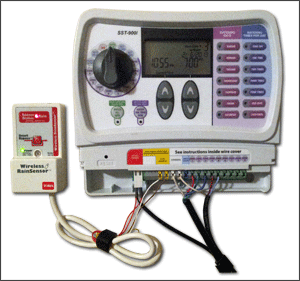
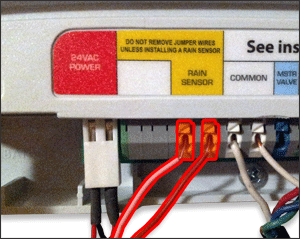
When there is continuity between the two contacts, the watering will commence normally. When the continuity is broken, the irrigation will immediately disable all solenoid valves in the sprinkler system.
So if a solution to this problem already exists, why go through all the trouble of creating a 'custom' rain bypass?
A Better Solution
The problem with rain sensors lies within how they are engineered. My particular rain sensor works by using absorbent cork discs to detect moisture. When it rains, the discs swell-up with water, depressing a switch which disables the watering. The watering is enabled again when the discs dry-out and contract, releasing the switch. There are two problems with this method:
- The bypass will only disable the watering after it has rained, it cannot predict rain. You may have just finished watering your garden minutes before it starts raining. Would you waste 200 gallons of water on your garden today if it were going to rain tomorrow?
- With most rain sensors, you cannot control how long to wait before the watering is re-enabled. In my particular case, the cork discs seem to dry out after 2-3 days and then watering commences. After rain, my soil is still extremely saturated with water after 2-3 days, and certainly doesn't need to be watered again. I would like to have more control over how long it takes before my watering schedule is re-enabled.
These shortcomings can be readily solved with a RPi. We can use its network connectivity to get current local weather conditions, forecasts, and even weather history. We can use the GPIO pins and a relay to break the continuity of the rain sensor contacts. Using Python code, we can combine internet connectivity with the ability to control IO to make the project behave however we want.
What You Will Learn:
- You will learn how to access weather forecast information using the Weather Underground forecast API
- You will learn how to create a configuration file to save the settings of your program even when your RPi is reset
- You will construct a simple circuit that will disable your irrigation controller when it rains. The system will provide notification that the system is enabled/disabled/not working even when it isn't plugged into a monitor.
- You will learn how to run the resulting script on your RPi as a startup service so it will automatically when your RPi is rebooted.
What You Will Need:
- Raspberry Pi with active internet connection and GPIO library installed
- A Weather Underground API developer account
- 1 - 1k resistor
- 3 - 51 ohm resistors
- 1 - zener diode
- 1 - 3v relay switch (I used a Goodsky RW-SH-103D)
- 1 - green led
- 1 - red led
- 1 - blinking red led
- 1 - 2n2222 transistor or similar (I used an NTE NTE123)
- An irrigation controller with a rain-bypass option. Mine is a Rain Bird SST-900i
Signing-Up For a Free Weather API Account:
Before you can access live weather feeds from wunderground.com, you will need to sign up to become a member of their weather API program. It is free to become a member, and you will be able to access weather data up to 500 times a day, which is way more than we would ever need for this project. Go to this site, and sign up for an account.
Choose the following settings when you sign up:
- STEP 1: Anvil plan - this will grant us access to hourly 10-day forecasts
- STEP 2: History add-on - sure, why not, we may want to use this later
- STEP 3: Developer - this plan should allow you to ping wunderground.com for weather information up to 500 calls per day, and up to 10 calls per minute.
After doing so, you will have access to your wunderground API key. Make note of this key, as you will need to add it to the python script.
Build It
First you will want to build the circuit according to this diagram:
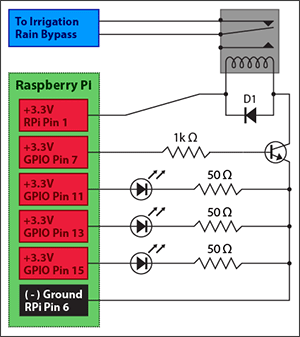
Here is a simpler schematic that will show you what your circuit will look like when complete:
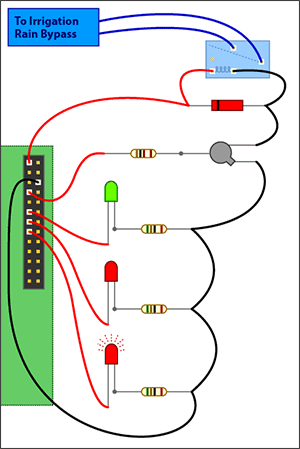
Program It
You can download the python source code for the program here. Remember, to access the GPIO pins with your Python script, you will need to run Python as a superuser. Launch IDLE IDE as a superuser by typing sudo idle into the terminal. If you choose to run the script from the terminal, type sudo python rain-bypass.py
- Enter your Weather Underground key at line 15 of the script. Replace the xxx's with your API code.
Run It
This project is designed to run in the dark confines of your garage next to your irrigation controller. After the initial setup, it can be disconnected from any I/O devices, such as your keyboard, mouse, or monitor.
- With your RPi connected to a monitor and keyboard, run the Python script. From the command prompt, change to the directory containing the script cd yourDirectoryName, and run sudo python rain-bypass.py
- Enter the 3 setting values when prompted. If you wish to completely 'reset' the program, simply delete the file named rain-bypass.cfg, then run the Python script again. You can delete the config file with the following terminal command:rm rain-bypass.cfg
- Now that our settings have been saved, close the window to kill the program.
- The next few steps will setup our program to run automatically whenever the RPi starts up. First we will need to change the file permission of our script to make it executable chmod +x rain-bypass.py
- Next, we want to edit the rc.local file to automatically run this script after boot. Let's use the Pico text editor to modify the this file sudo pico /etc/rc.local
- Add the following lines right before the exit 0 line. Change the path to your script if it is different:printf "Starting Pi Weather Service..."When you are done, your file should look something like this:
python /home/pi/working-python/rain-bypass.py &#!/bin/sh -eHit ctrl + o to save the file
#
# rc.local
#
# The rc.local header comments have been truncated for this tutorial
printf "Starting Pi Weather Service..."
python /home/pi/working-python/rain-bypass.py &
exit 0
- Wireless users: This project requires an internet connection. If you are using WiFi adapter, now is a good time to make sure that you have configured your WiFi network settings using the WiFi Config tool. Open a web browser window to confirm that you have an active internet connection.
- Additionally, you may want to run the raspi-config configuration tool to tell your RPi not to boot into the GUI OS.
- Now that you are done with the setup, you can unplug your RPi from your monitor, keyboard, and power adapter. Place your RPi near your irrigation controller. Attach the two leads from the relay to the rain sensor leads on the irrigation controller, as detailed in the diagrams. Plug in your RPi and you should be ready to go.
Surely you will find a better way to mount your project than this:
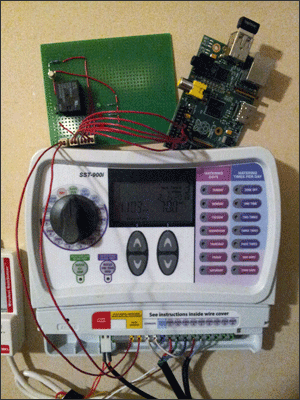
How It Works:
The script requests a 9-day weather report from Weather Underground at normal intervals. If rain is detected within the "delay days" setting, the watering is disabled. If rain is detected on the current day, then the system is disabled for the number of "delay days", after which is is re-enabled.
- Green light: watering is enabled. It hasn't rained recently, and no rain has been predicted
- Red Light: watering is disabled. It has either rained recently, or rain has been predicted in the near future
- Blinking Light: There is either a problem with the code, your internet connection, or accessing data from the wunderground api (did you remember to sign up for a api key and place it in the python script at line 15?)
When running at bootup, the weather service may appear to hang the system. Not to worry, simply type your RPi username and hit enter, then your RPi password and enter. You should then be able to launch the GUI OS normally using the startx command.
Some Ideas:
I've pieced together a relatively simple solution here. Once you get started, you'll probably want to make some modifications. Here are a few ideas:
- Get rid of the irrigation controller and control the solenoid valves directly with your RPi. Run your RPi as a server with a web-interface to contol watering.
- Have the bypass trigger after a certain amount of rain has fallen. Disable watering for different periods of time depending on depth of rain.
- Power your Rpi off the same ac adapter as your irrigation controller.
- Add an LCD screen to the project:

